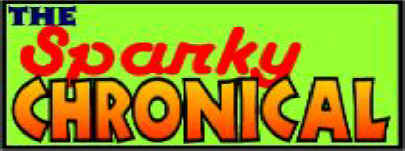|
July 1, 2003.
Jim ordered some little plastic bridges that
will sit on top of the bridge supports in "Fearsome
Gorge," and permit the trains to go over the gorge without
the passengers having to be "fearsome" of a crash.
The little bridge is made by LGB, who makes a lot of the G-Scale train
things we have, and is about 18" long and 6" wide.
little plastic bridges that
will sit on top of the bridge supports in "Fearsome
Gorge," and permit the trains to go over the gorge without
the passengers having to be "fearsome" of a crash.
The little bridge is made by LGB, who makes a lot of the G-Scale train
things we have, and is about 18" long and 6" wide. The
next things Jim ordered was some s witches
(Reel train buffs call them "Turnouts.") The
one in the pitcher at the right has a lecktrical turner-outer
motor on one side, and you ken hook up some wires and a special
lecktrical switch to it, so you can then put in a special sensor
thingy that listens fer when the train is coming and then it
changes the turnout so the train goes a certain direction.
Then you ken make the train stop and maybe wait fer another train
to go past before it starts up and goes again. This works
reel good in a garden railroad, cuz you fer sure don't want that
train to wreck and end up in the Petunia patch, where it might
wreck a lot of your wife's Petunias and get you in trubble. witches
(Reel train buffs call them "Turnouts.") The
one in the pitcher at the right has a lecktrical turner-outer
motor on one side, and you ken hook up some wires and a special
lecktrical switch to it, so you can then put in a special sensor
thingy that listens fer when the train is coming and then it
changes the turnout so the train goes a certain direction.
Then you ken make the train stop and maybe wait fer another train
to go past before it starts up and goes again. This works
reel good in a garden railroad, cuz you fer sure don't want that
train to wreck and end up in the Petunia patch, where it might
wreck a lot of your wife's Petunias and get you in trubble. It's
reel lecktronical, so I won't try to explain it here, cuz I don't
know nothing about it either, 'cept that it is specially made to
work in a garden railroad and therefore it is waterproof and dirt
proof so it don't get messed up too fast. Jim
also ordered some other thingys
to fasten the tracks together when they get to the Turnouts, cuz when you try to
solder regular tracks to the end of the track that's part of the turnout,
the plastic parts start to melt, and the turnout might not turn
out any more! Fer
that reason some clever inventor invented some brass rail
fasteners that you put on the ends of the track rails and tighten
a special screw and then it holds the tracks together and makes
sure the lecktrick-city gets through so the train will run smooth.
together when they get to the Turnouts, cuz when you try to
solder regular tracks to the end of the track that's part of the turnout,
the plastic parts start to melt, and the turnout might not turn
out any more! Fer
that reason some clever inventor invented some brass rail
fasteners that you put on the ends of the track rails and tighten
a special screw and then it holds the tracks together and makes
sure the lecktrick-city gets through so the train will run smooth. When
you don't fasten the tracks correctly, the lecktrik-city sometimes
gets lost or simply jest can't jump over to the next piece of
track, so the locomotives will often
start and stop and wiggle and jiggle all over the place, and
sometimes even get into a wreck in case one train stops cuz it got
to a section of track that was either dirty on top or didn't have
a good lecktrickal connection, and the one behind keeps going and
crashes into it reel fast. Jim
hates it when it does that, so he always solders together the
pieces of track that make up most of the railroad, then uses these
"Split Jaw Rail Clamps" to hold the tracks wherever he
can't solder things safely. That way, the weather that hits
a garden railroad won't make the track lecktrik-city get confused
and fall out onto the ground, and maybe fry some of the flowers
nearby. Cribbing Since
this little town that will be served by the railroad is to be
located on various hills, it will need fer the dirt to be retained
by some large rocks as well as little retaining walls, commonly called "Cribbing." To
make the cribbing, Jim jest chops up all the old scrap redwood and
cedar boards that have accumulated over the years. He first "rips" the scrap boards on his bandsaw, to about
1/2" square. Then he cuts them off to about 5"
long. Then Gloria drills a 5/32" hole in each
end. And finally, Jim cuts a notch in both ends of half of
them, and in the remaining pieces he cuts a notch in only 1 end,
like shown in the pitcher.
"rips" the scrap boards on his bandsaw, to about
1/2" square. Then he cuts them off to about 5"
long. Then Gloria drills a 5/32" hole in each
end. And finally, Jim cuts a notch in both ends of half of
them, and in the remaining pieces he cuts a notch in only 1 end,
like shown in the pitcher. They
are assembled in place in the dirt by pushing pieces of 3/32"
bronze welding rods into the dirt and through the cribbing
pieces. Then the wall is built up one row at a time until
the correct height is achieved. Next, the top of the wall
will be leveled by pushing dirt under low spots or tapping high
spots down into the dirt. The tips of the welding rods are
then bent over to hold the cribbing pieces in position. After leveling, the space in back
is gradually backfilled, being careful to locate the "Deadman"
pieces of cribbing so the dirt will help keep the finished wall
from tilting forward.
.
Cribbing
retaining walls are typically used for relatively short distances,
broken up with large rocks, to better simulate the way track
roadbeds are built in the real railways.
.
 Sunburned
Frog? Sunburned
Frog?
We have a wild frog
that lives in our pond, and he jest sits on them lily pads
and doesn't do anything constructive or even act cute like
the goldfish. Then on July 6th he sat on that lily
all day long, in the hot sun. The next day he was
missing in action. Does that mean that he got
sunburned, or was he jest having a lazier-than-usual day? |
July
7, 2003. Weather: 6:30 a.m.,
66 F., sunny, light breeze. Great day to be working outside on the
garden railroad, but after building the 2 retaining walls shown above,
Jim ran out of pieces of wooden cribbing and
had to go inside and cut up some more. He
used up all the redwood and cedar scraps, and decided to cut up
several boxes of assorted oak scraps, due to the fact that oak is
used outdoors in some parts of the country, and also due to the
fact that otherwise Gloria will, sooner or later, jest throw out
them scraps. (Did I ever mention that he's half Scotch and
half Irish? The Scotch half wants to save everything and the
Irish half is too lazy to clean up or throw anything away). NOON:
Sparky looked out the back door from the basement, and the UPS
package from Watts Train Shop was leaning against the back
door. Jim was making so much racket with his saws, we didn't
hear the UPS driver, and the service was better than he had
expected, considering the 4th of July was expected to wreak havoc
with the delivery schedule. July
8, 2003. Weather:
6:30 a.m., 68 F., sunny, slight breeze.  Great
day for a bike ride, so that's what Jim did, and he said that the
yard can wait until later in the day. Great
day for a bike ride, so that's what Jim did, and he said that the
yard can wait until later in the day.
Weather at noon: 96 F., Temperature at 6 p.m, 101 F. Good
afternoon to stay inside and work on cutting more pieces of
cribbing.
|

